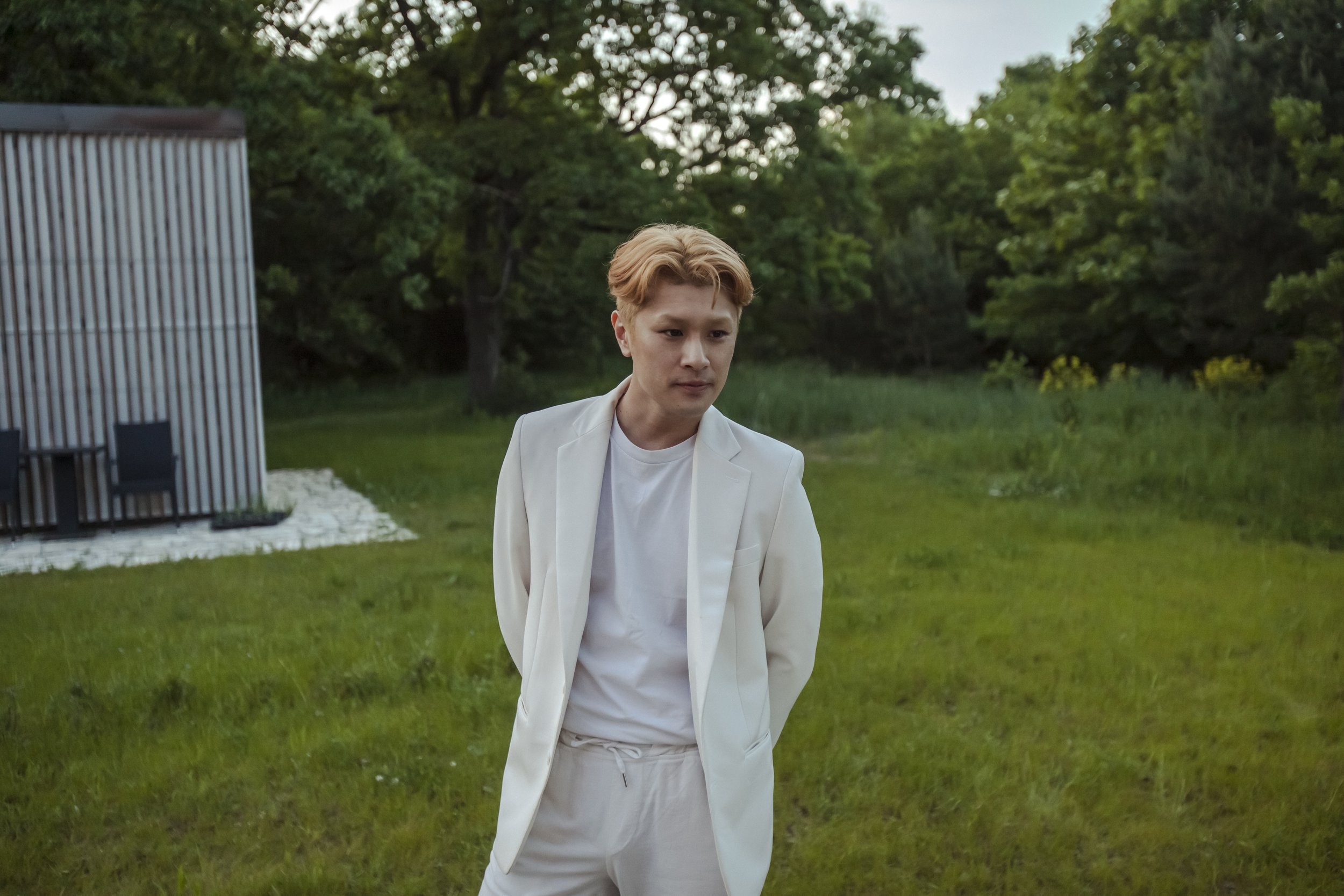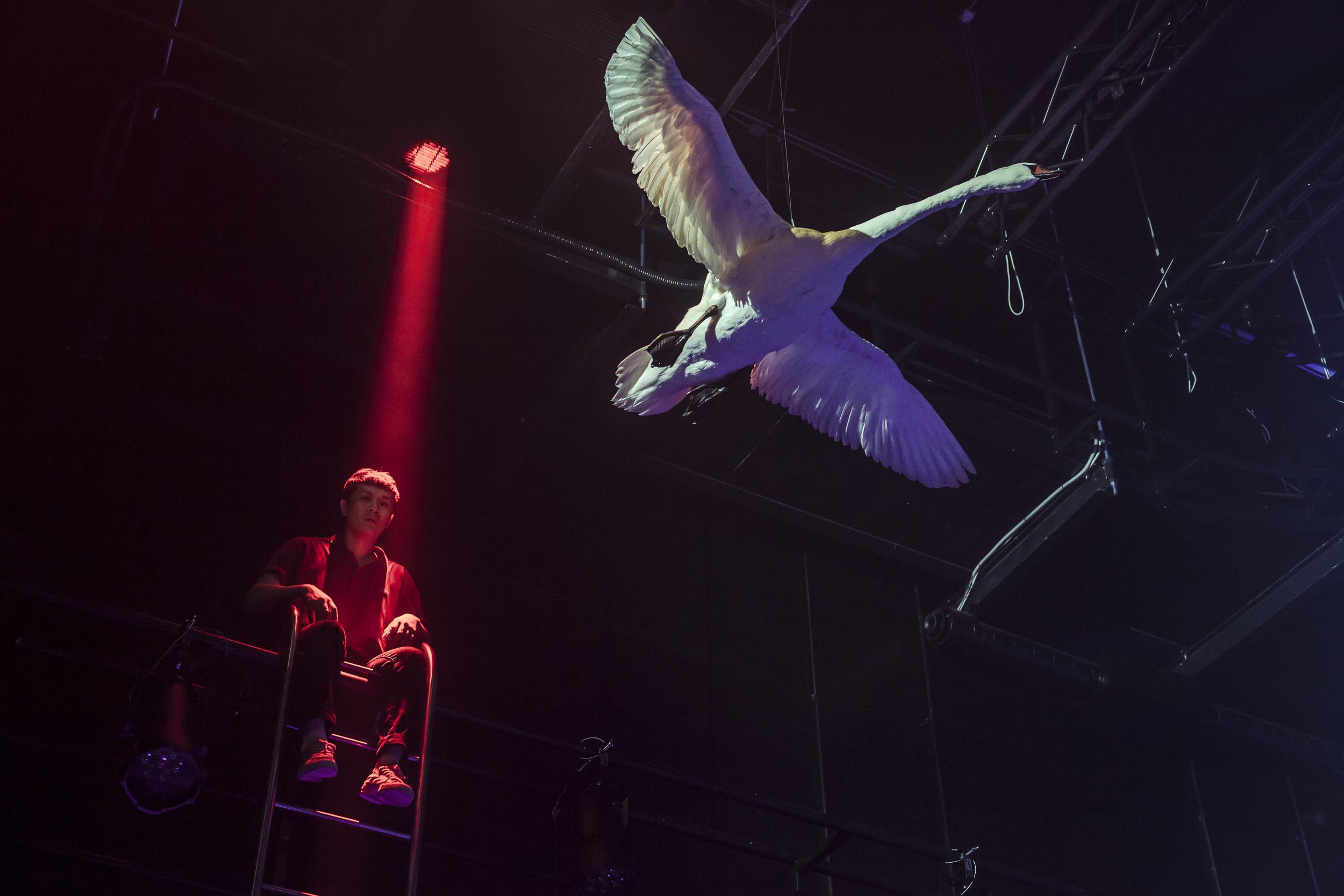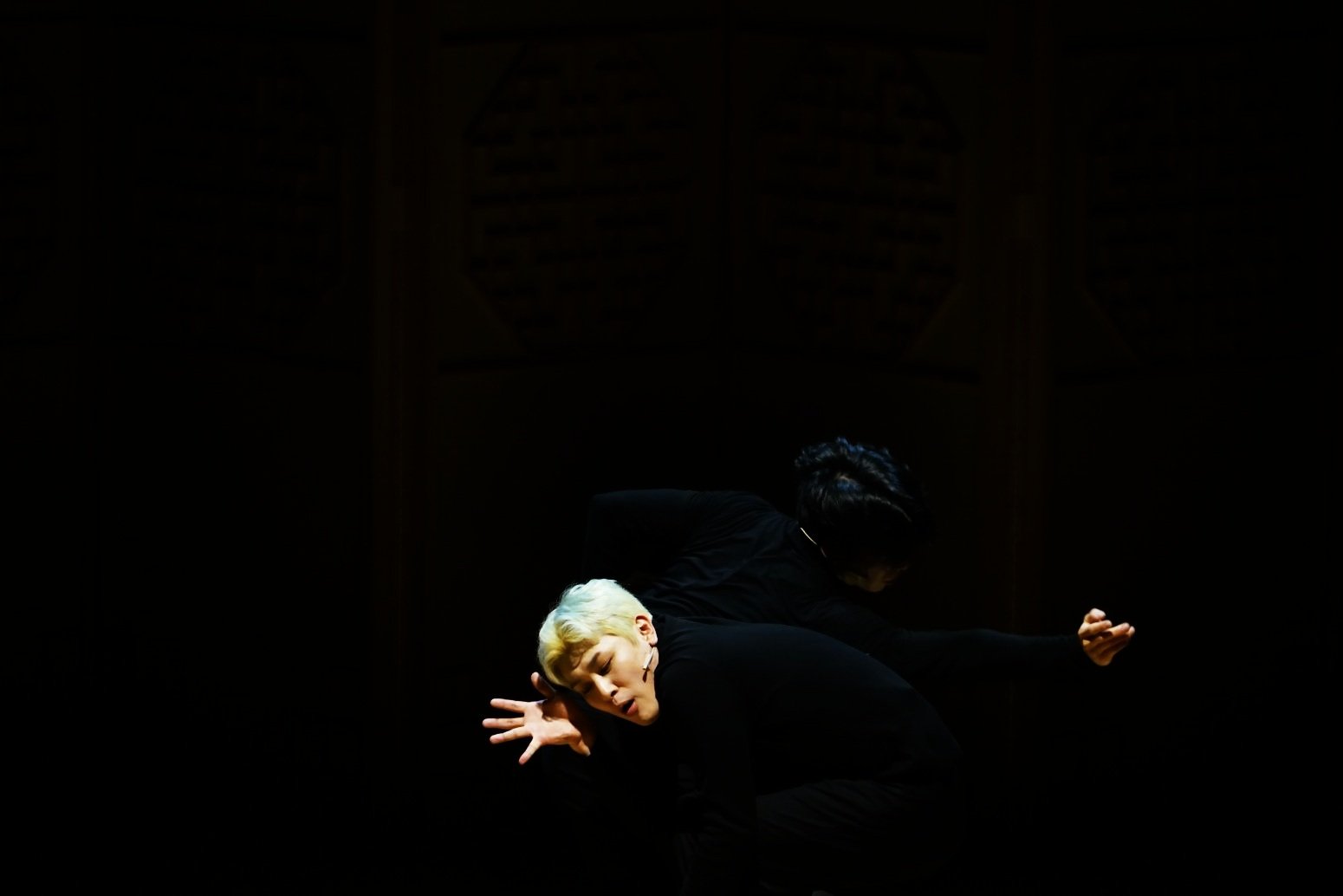
‘My house is like my mother's arms.
It's warm and cozy,
and whatever happens,
it's on my side
and makes me feel
comfortable.
My house is also a place where I can cry and laugh freely and watch myself grow.
When we come home, we become a seed
buried in the soil. It's a place where I grow up and grow old, take a shower, watering me with the sunlight coming in through the window.’
“나의 집은 엄마의 품같은 곳이다. 따뜻하고 아늑하며 무슨일이 벌어지든 나의 편이 되어주며 나를 편안 하게 해준다. 또한 마음 껏 울고 웃을 수 있는 곳이며 나를 성장할 수 있도록 지켜보는 곳이기도 한다. 집에 오면 흙에 파뭍혀 있는 씨앗이 된다. 창문에 들어오는 햇살을 받고 샤워를 하며 나에게 물을 주며 나 는 그렇게 성장하고 늙어 가는 곳이다.”
A BODY TO DWELL deviser, performer
SEOHWON JI

SEOHWON JI (1989) is a physical creator, performer, director and choreographer from South Korea. He graduated from an MA in Contemporary Physical Performance Making at The Estonian Academy of Music and Theatre, as well as Seoul Traditional Arts High School and Chung-Ang University, where he studied theatre, directing, modern dance, Korean dance, singing, and traditional mask dance. He has performed at the Arts Festival in Singapore, the Auckland Arts Festival in New Zealand, the Akita Dance Festival in Japan and Aspendos International Opera Festival in Turkey. His awards include the Grand Prize on 36th Seoul Dance Festival “Horn ” in 2015, and the Musical Award on Daegu International Music Festival (DIMF) in 2018.

SEOHWON JI has been working with, studying and developing an artistic methodology for performance called HEBS.
HEBS
- Happening, Energy, Breathing, Sound & Space -
‘I’m still researching it.’
In 2022, Seohwon JI opened a HEBS workshop in Seoul. Based on the five HEBS elements, the workshop investigates with artists the ways in which these actions establish the creative process and structure that constitutes a performance.
‘I opened a workshop to share what I’ve been learning
and to play with what has been shared.’
‘I think all life and art comes from within us,
I think it starts with the body regardless of genre.’
피지컬 크리에이터란 신체를 창작하고
신체를 통하여 무언가를 창작해내는 사람을 말합니다.
제가 그동안 작업하고 공부하며 HEBS라는 공연을 구성하는 개발과정 메소드를 만들었고 지금도 연구하고 있습니다.
우선 HEBS란
Happening(사건), Energy(에너지), Breath(호흡), Sound(소리)& Space(공간)의 약자를 뜻합니다.
그동안 제가 배워왔던 것을 공유하고 공유된 것으로 함께 놀고자 워크샵을 열게 되었습니다.
모든 삶과 예술은 ‘나’ 로부터 나온다고 생각합니다.
그리고 장르 구분 없이 ‘신체’로 부터 시작된다고 생각합니다.
hebs
happening
can consist of experiences that humans have in their lives. Even if it's the same life every day, we have a happening every day. We have conflicts over this happening, find ways to solve the problem and come up with measures to prevent it as the problem becomes solved or remains unsolved.
Performers can reproduce or manipulate situations, events, conflicts, emotions, relationships and results by bringing their experiences into the performance development process. They can then organise them in the desired direction according to the theme of the performance. Examples of performers bringing experiences in the process of developing performances include experiences related to love, separation, pain, happiness, accidents and betrayal.
해프닝은 인간이 살아가면서 겪는 경험들로 구성할 수 있다. 매일 똑같은 삶이라 할 지라도 우리는 매일 해프닝이 일어난다. 이 해프닝에 대해서 갈등을 겪고, 그 문제를 해결하기위해 방법을 찾고, 문제가 해결되거나 해결되지 못함에 따라서 대책을 마련하고 예방하며 살아간다.
공연자는 자신이 겪었던 경험을 공연 개발 과정으로 가져와서 상황, 사건, 갈등, 감정, 관계, 결과 등을 재연하거나 조작 할 수 있으며, 공연의 주제에 따라 공연자가 원하는 방향성으로 구성할 수 있다. 공연자가 공연 개발 과정에서 경험을 가져오는 예로 사랑, 이별, 고통, 행복, 사고, 배신 등에 관한 경험을 가지고 올 수 있다.
energy
can be seen as the connection of relationships in the process of performance development. The connection between the performer and the performer, and the connection between the performer and the audience, can be seen as having a relationship with this energy. Performers can control the size, texture, shape, feeling, weight, stress, moderation, and length of the performers' movements by using energy in the process of developing the performance. For example, it can be composed of dynamic movements by amplifying the amount of energy by repeating one operation or by strengthening it in a smooth operation.
에너지는 공연 개발 과정에서 관계의 연결성으로 볼 수 있다. 공연자와 공연자와의 연결, 공연자와 관객의 연결은 이 에너지로 관계를 맺는 것이라 볼 수 있다. 공연자는 공연 개발과정에서 에너지를 사용함으로써 공연자 움직임의 크기와 질감, 형태, 느낌, 무게, 강세, 절제, 길이 등을 조절 할 수 있게 된다. 예를 들어 한 가지 동작을 반복하여 에너지의 양을 증폭시키거나 부드러운 동작에서 강세를 주어 다이나믹한 움직임으로 구성 할 수 있게 된다.
breath
Some people are very unaware of how their breathing rests. The amount, length and speed of breathing according to changes in the state of mind, etc. It is necessary for performers to be aware of their breathing. Breathing plays a role in transferring from one energy to another energy and also refers to the performer's internal and external mental state. In addition, the quality of the performer's movement can be determined by the state of this breathing. Breathing facilitates verbal and nonverbal communication, and the audience can feel the breathing of the performer. It can be seen that the audience also follows the performer's breathing. Breathing plays a role in connecting performers and audiences.
사람들은 자신의 호흡이 어떻게 쉬어지는 지에 대해서 많이 인지하고 있지 않다고 생각한다. 자신의 호흡의 양, 길이, 심리상태의 변화의 따른 호흡의 속도 등. 하지만 공연자들은 자신의 호흡에 대해 인식하고 있어야 한다고 생각한다. 호흡은 에너지에서 다른 에너지로 이동시켜주는 역할을 하고 공연자의 내, 외적 심리상태를 의미하기도 한다.또한공연자의움직임의 퀄리티는이호흡의상태로결정될수있기때문이다. 호흡은 언어적, 비언어적 의사소통을 원활 하게 해주며 공연자의 호흡은 관객도 느낄 수 있음으로 관객도 공연자의 호흡을 따라가게 된다고 볼 수 있다. 호흡은 공연자와 관객들 을 연결시켜주는 역할을 한다.
sound
can be created by using the performer's voice (words, songs, exclamations, etc.) or by hitting or tapping parts of the body. It is important to have a certain purpose and meaning when creating sound in the process of developing a performance. Sound plays a role in maximising the scene of the performance, creating the performer's psychological state, atmosphere, environment and situation, and delivering information on the performance scene to the audience. It plays a role in maximising the message and imagination delivered to the audience by stimulating the audience's hearing, such as the height, volume, length and beat of the performance.
사운드는 공연자의 목소리(말, 노래, 감탄사 등)를 사용하거나 신체의 일부분을 때리거나 두드려서 만들어 낼 수 있다. 공연 개발 과정에서 사운드를 만들 어 낼 때 어떤 목적과 의미를 갖고 있는 것이 중요하다. 사운드는 공연의 장면을 극대화 시키거나 공연자의 심리상태, 분위기, 환경, 상황 등을 조성하고 공연 장면의 정보를 관객에게 전달하는 역할을 한다. 목소리의 높낮이와 음량, 길이, 박자 등 공연의 시각적인 부분을 관객의 청각을 자극 시켜 관객에게 전달되는 메세지와 상상을 극대화 시킬 수 있도록 도와주는 역할을 한다.
space
Here, the meaning of space does not mean 'performance hall' or 'stage', but 'space' from the experience of the performer. It refers to a place where a performer is, could be in nature, the environment, based on their thought and on their experience in the process of developing a performance, or it is an imaginary place that they have not experienced. I think the intention or direction of the performer is determined depending on what space the performer selects and organises, and the audience can see the world built by the performer. Examples include the sea, desert, swamp, black hole, space, etc.
여기서 공간의 의미란 '공연장', '무대'를 뜻 하는 것이 아닌 공연자의 경험에서 나오는 '공간'을 뜻 한다. 공연자가 공연 개발 과정에서 경험을 바탕으로 생각 되어지는 장소, 경험해보지 못한 상상 속의 장소, 자연, 환경 등을 의미한다. 공연자가 어떤 공간을 선택하고 구성하느냐에 따라 공연자의 의도나 방향성이 정해지고, 관객들은 공연자가 구축한 세계를 볼 수 있게 된다고 생각한다. 바다, 사막, 늪지대, 블랙홀, 우주 등 을 예로 들 수 있다.